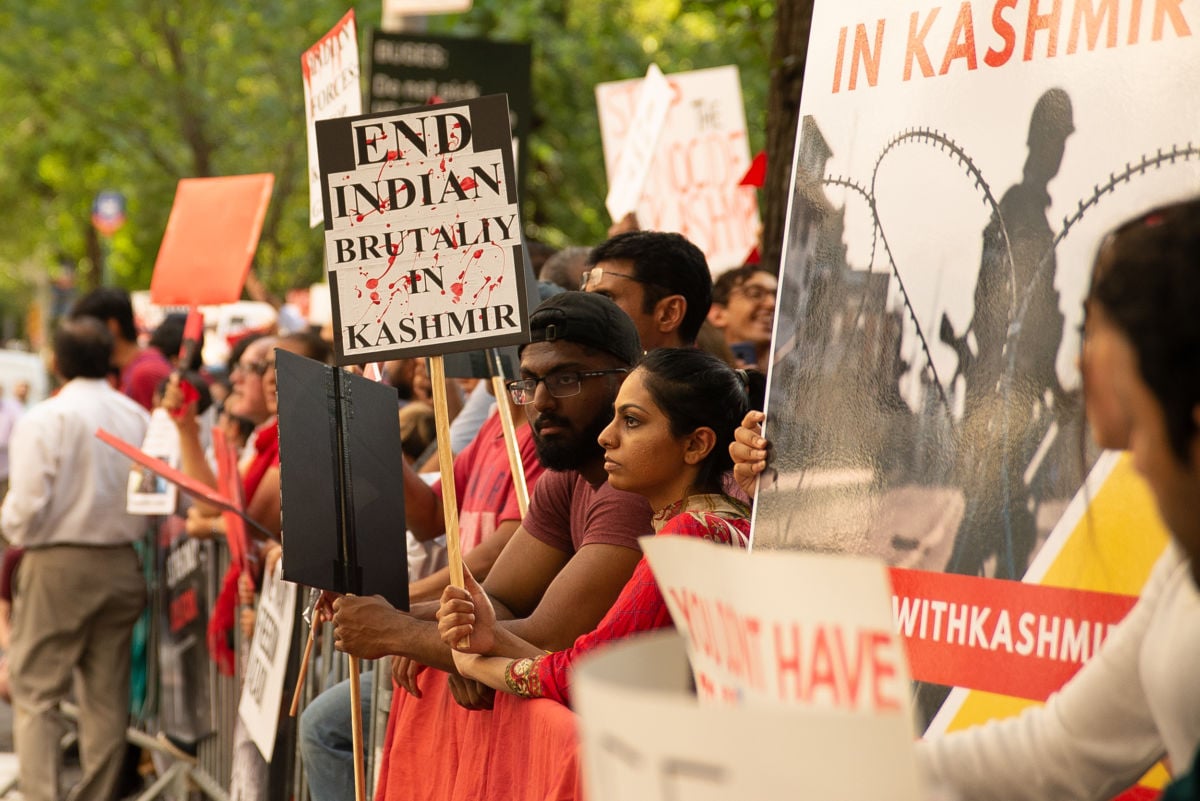
By Skanda Kadirgamar, Truthout Published August 16, 2019

Tragedy is unfolding in Kashmir. Split between India and Pakistan, the state has been under military occupation as a result of the partition of the subcontinent in 1947 and a war between the two powers the following year. On August 5, however, the right-wing Bharatiya Janata Party-led government (BJP) annulled laws that framed a fragile autonomy for people living on the Indian side. Law 307 — which conferred autonomy upon the state over all matters with the exception of defense, foreign affairs and communication — and 35A, which prevented non-residents from purchasing property, were scrapped by Indian Home Secretary Amit Shah. This would allow Indians to buy land in Kashmir, which has been a key point of a Hindu supremacist agenda bent on marginalizing Muslims throughout South Asia.
India’s leaders have long viewed incorporating Kashmir as essential for their nationalist project. Moreover, they view support for Kashmiri autonomy and all forms of protest against the occupation as evidence of Pakistani aggression. India being led by a Hindu nationalist administration for the past five years and the lack of a unified parliamentary opposition to the BJP have only escalated these dynamics. This jingoism has contributed to marginalizing major concerns about Kashmiris’ right to self-determination.
Moreover, the cancellation of both laws coincides with a massive upswing in violence by the Indian state. Political leaders, even those who favor unification with India, were placed under house arrest. Human rights leaders have been detained. More Indian troops surged into what is already one of the world’s most militarized areas. Media and communication were blacked out as internet and mobile devices were taken offline. These developments have shaken Kashmiris everywhere.
Resistance has emerged — not only within Kashmir, but throughout the Kashmiri diaspora. Members of the diaspora have been largely responsible for subverting the information blackout, encouraging little leaks where they can. This entails furtive communication with friends or family members taking advantage of sparse Wi-Fi in hospitals and other places. Journalists in the area say that they are unable to do their work due to the suspension of communications infrastructure and active obstruction by the military.
Many commentators say India is setting the stage for an ethnic cleansing that would drive out Muslim residents and replace them with Hindu settlers. This has inspired historic resistance as Kashmiris around the world are leading protests against these acts of aggression.
Diaspora Communities Lead in Acts of Solidarity
On August 9, Kashmiris and their allies in New York City turned the area around the Indian consulate into a launching point for a global wave of solidarity for Kashmiri self-determination. Demonstrations are taking place across the country and across the world. In the past, mass outpourings of this scale have been relegated within Kashmir itself. The show of support has been unprecedented.
During the Stand With Kashmir rally in New York, Kashmiri scholar and activist Hafsa Kanjwal addressed a crowd posed half a block away from the Indian consulate. The Kashmiris who had turned out to demonstrate had a plethora of diverse allies.
“Today we have people from all over New York City,” Kanjwal announced, “from every single solidarity movement there is!”
Palestinian organizers, Syrians opposing the regime of Bashar al-Assad, Filipinos rejecting dictator Rodrigo Duterte, activists for Puerto Rican self-determination and anti-gentrification activists from Harlem were all in attendance.
“This is a historic moment,” Kanjwal said. “The Indian government has shown the world what its true intentions are and what they’ve always been. To completely subjugate and suppress a people who have been demanding freedom for over 70 years. That changes today! We are not going to sit by as India murders, rapes and ethnically cleanses Kashmiris from their land!”
Kashmiris’ have waged a decades-long struggle for self-determination. In 1949, the United Nations urged a plebiscite or referendum on whether Kashmir would become part of Pakistan of India. Amidst all this, demands for independence also became popular amongst Kashmiris. In the 1950s, India essentially abandoned this process. This would spark an armed uprising in the late 1980s.
Though armed resistance in Kashmir gradually waned in the 2000s as thousands of insurgents died and people grew weary of fighting, Indian armed forces remain in the region. Kashmiris continued to resist, though. Tactical emphasis shifted to strikes, marches and, at times, pelting military police with stones. Guns had largely vanished from Kashmiri hands.
Regardless, India’s responses have consistently been traumatizing. Mass rape and sexual violence are touchstones of the regional superpower’s collective punishment strategy for the region. The army’s alleged treatment of the villages of Kunan and Poshpora during the 1990s insurgency stands out as an example. Between 23 and 100 women were said to have been raped by soldiers who claimed to be looking for fighters. Women presumed to be sympathetic to militants are often raped by soldiers. The Indian army has “punished” Kashmiri fighters by raping their female family members as well.
In an overview of abuses by Indian army personnel, Human Rights Watch (HRW) noted that the majority of Kashmiris who were detained were tortured. According to HRW’s report, torture in Kashmir is “used to coerce detainees to reveal information about suspected militants or to confess to militant activity” and that “it is also used to punish detainees who are believed to support or sympathize with … militants and create a climate of political repression.” HRW also noted that the forms of torture “included severe beatings, electric shock, suspension by the feet or hands, stretching the legs apart, burning with heated objects, sexual molestation and psychological deprivation.”
Mass maiming is also a crucial part of the offensive against Kashmiri liberation. Enraged by the killing of Burhan Wani, a popular militant, Kashmiris turned out in crowds to protest the military’s presence. In 2016, the army responded by unleashing an “epidemic of dead eyes” in Jammu and Kashmir by using blinding pellet guns and tear gas on demonstrators. Hundreds of people, many of them young, who were struck in the face by pellet ammunition had their eyes perforated and torn asunder.
Earlier this year, India also showcased its penchant for forcing compliance by making Kashmiris disappear. In February, the occupying forces carried out mass arrests after more than 40 soldiers in the town of Pulwama were killed in a suicide attack by a 22-year-old named Adil Ahmad Dar. The mass blinding of 2016 has been suggested as a factor behind Dar’s decision to carry out the bombing. Hindu mobs in Kashmir and across India began attacking Kashmiri Muslims as well.
Among those seized by the Indian forces were leaders of the Hurriyat Conference, an organization of multiple political groups that spearheads the nonviolent resistance to India’s presence. Jamaat-e-Islami, a religious-political organization, was also banned by the Indian government. The targets of the crackdown were not limited to political leaders. India also used the Pulwama attack as a pretext to round up hundreds of young Kashmiri men for either having participated in protests or simply being suspected of holding pro-freedom sympathies. The ban on Jamaat-e-Islami compounded the impact on Kashmiri youth as the organization provided schooling for thousands.
Another dimension of the occupation is its impact on intercommunity relations among Kashmiris. Muslims and the Kashmiri Pandits, a community of Brahmin Hindus, have been pitted against each other by India’s territorial claims. The Pandits’ stories have been politicized and thus interpreted in a number of different ways. Many Pandits left Indian-occupied Jammu and Kashmir in the early 1990s, after the insurgency had begun. The Hindu right wing seized upon this as evidence of a cleansing or genocide carried out by the Muslim community. This narrative has become a popular with diaspora Pandits who align with the agenda of the BJP. This has become a key talking point in light of the repeal of laws 370 and 35A, which some Pandits have hailed as enabling their ability to finally return home.
Pandits who stayed in Kashmir, however, contradict that version of what happened. While acknowledging that communal tensions did flare up during the insurgency, they point to discrepancies in the Hindu right’s narrative of intercommunity violence. They also criticize their Muslim neighbors for having been too slow to act when insurgents threatened Pandits. Additionally, while acknowledging that killings of Kashmiri Hindus did take place during the 1990s, they also note that the Hindu right dramatically inflates the number of dead and presents a faulty timeline of events. Crucially, this narrative emphasizes that Kashmiri Muslims often supported and defended their Pandit neighbors.
These Pandits often were not financially able to leave Kashmir, but also often cite relationships with their Muslim neighbors as having motivated them to stay. Many Muslims were willing to defend their Pandit friends and decry insurgent aggression. Notably, Pandit scholars outside of Kashmir have corroborated this account and are calling on their community to reimagine the terms by which they will return home.
Some Kashmiri activists say that this model of intercommunity solidarity is being threatened by the Hindu right’s vision of repatriating Pandits. They worry that the repeal of both 370 and 35A could enable a situation similar to Israeli colonization of the West Bank with Muslims being physically segregated and kept away from areas designated for Hindus.
Speaking to Truthout, Hafsa Kanjwal volunteered suggestions for those looking to stop India’s “grotesque escalation” in Kashmir. Those just learning of the struggle in Kashmir must understand that call for self-determination is not merely coming from “grassroots freedom movements but is enshrined in multiple UN resolutions,” says Kanjwal. In other words, violations of Kashmiri autonomy raise serious concerns when it comes to international law.
Kanjwal also says that the most important thing those who have become allies to the freedom movement can do is to help change the narrative that Kashmir is an “integral part” of India. This means finding connections and parallels with other solidarity movements that oppose occupation, like the struggle against Israeli apartheid. They also need to dispel the assertion that every uprising in Kashmir is instigated by Pakistan, which is prominent amongst the “myths that the Indian state peddles.”
Skanda Kadirgamar is a New York-based writer who covers race, labor, housing, policing and South Asia.
